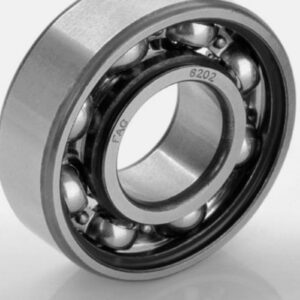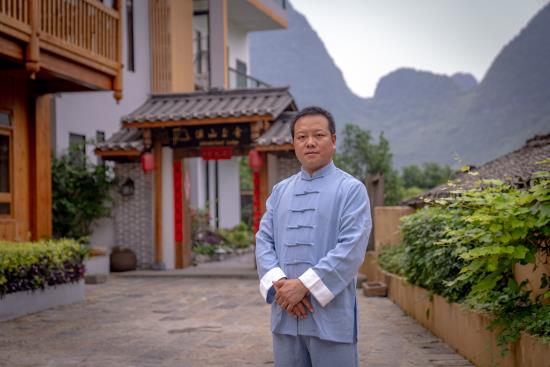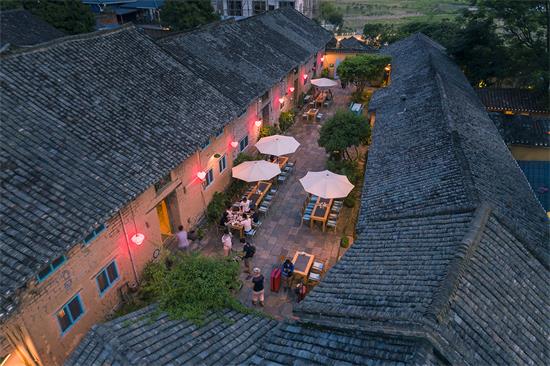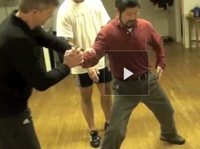Size of kua movements. Template is the crank shaft. Maintain the rod in line. Size of the elbow and kua is the size of internal power, it has to be so big that you feel you are losing balance from inside. Chineses exercise: wash the waist. Kua cranking open. Master Chen Zhonghua demonstrated how big the opening can be in the kua and the opposite armpit in the forms.
Read more
Yuxin Liu
1.Lock the middle, move the two ends, 3 ways; 2. Lock the two ends in a twisted way, break the middle, when doing the lock, the intention of directing the energy is to the middle. 3 ways. The ability to catch. Six sealing four closing. Two hands 90 degree hold a stick, elbows squeeze into the hands, creating forward and back force, accurately aiming to the center of the stick. It is two sets of hands.
Martial arts is not a sport. Real taiji (effect) is dramatic, turning of the joints.
Stretch more, reach far and try to touch everything outside you.
Read more
Torso upright. We tend to lean forward in the forms. White crane spreads its wings, brush the knee, initial closing. We can only lean back, not forward or sideways.
Six sealing four closing. Before the stepping, no movements, only rotate, two gears from the front shoulder-kua axis.
Ground dragon. Put the R hand, shoulder, head and knee onto a wall, push kua to the wall, stick to the wall as one piece, L foot propels the body back.
Read more
Three parts in ball bearing: outer ring, inner ring and the balls in between we consider as one part.

Taiji is three.
Three steps: 1. Different parts of the body are strong, hard and stiff, which able to combine and recombine into pieces which have the same quality, like the rings and the balls. 2. Establish relationship or connection between different pieces through joints, like the balls seamlessly in between the two rings (through separator and tracks on the rings), engine oil is the joints. 3. Press the button to run the machine.
Read more
Kua exercise: 1. Use front kua to draw the circle. Upper body and arms are locked in position, one piece, no move, only use and exaggerate kua movement. You can fold forward and lean back, feet can move to make it even bigger. 2. Use back kua as a hinge/pivot. Front knee can be lifted, lock upper body, arms and front leg as one piece, tight, hinge from the back kua.
All the moves in Chen Style Taijiquan are designed to make your opponent fall onto the back of the head hitting a rock.
Read more
Closed circuit. Ball bearing. Body part, passive/inactive like a sandbag not a basketball. Being charged.
Six sealing and four closing can explain everything. Training model (small element): kua drives the arm. Lock the shape of the arm, arm parallel to the floow, use kua to propel the elbow transferring to the hand. Push into the front foot or back foot, the arm is positive circle or negative circle. Hand elbow shoulder is on a table, no turning of the hand. Arm is like the bifolding door. Clear one on one transmission. Kua pumps upward to the shoulder, shoulder stays down, it goes to the elbow. T, vertical to horizontal. By passing the shoulder, kua is connected directly to the elbow then to the hand. Elbow is a dot. Hong chopped his shoulders off. Upper dantian needs be clear and light. Like a bridge, from a square, chop the corners off, form an arc. Transfer of energy, cannot get stuck on the shoulders. When done right, you are always with the flow and the opponent is always against the flow.
Read more
Wind up the clock. Lock one end to create spiral. 1.use body strength 2.body has the shape/structure of half pipe or spiral.
Read more
Chen Ronghua is a disciple of Chen Zhonghua. He owns a Practical Metthod school in Yangshuo, Guangxi Province.
企业家陈荣华用智慧打造格格树民宿品牌被誉为阳朔最美风景 Gegeshu B&B brand created by Entrepreneur Chen Ronghua is known as the most beautiful scenery in Yangshuo

桂林阳朔格格树饭店有限公司董事长陈荣华 Chen Ronghua, Chairman of Guilin Yangshuo Gegeshu Hotel Co., Ltd.
玩在阳朔,吃住在格格树民宿,这是去桂林游玩领略桂林山水甲天下必须要去的一个地方,格格树民宿与桂林山水甲天下相融在一起,还有独特之处,那就是承载了中西结合的旅游业底蕴,而格格树民宿的经营者、著名企业家陈荣华先生与之更是有着说不完的故事。
While touring in Yangshuo and enjoying the unparalleled landscape of Guilin, dining and staying in Gegeshu B&B is a must. There is a unique feature in Gegeshu B&B and Guilin landscape, that is the combination of Chinese and Western tourism, with which Mr. Chen Ronghua, the operator and well-known entrepreneur of Gegeshu B&B, has too many stories to tell.

格格树民宿如诗如画夜景 Picturesque night view of Gegeshu B&B
Train the scissors as an ability/skill. Two way split, in both elbow and armpit, 2 dots. In use or push hands, it is paper cut model, with one side being fixed, like an opponent holding you and you cannot move. Like the crab pincers.
Train the elbow. Thread through the needle, push into pull. Pass the demarcation line/dot. We always move after going through the hole. Before that, it is a push. Elbow has to pass the line, go over.
Read more
3 beats. Cloud hands. When it is 3, the middle is stable and not affected, 2 is swollen but time is taken.
Stepping in six sealing four closing, avoid double heavy, arms go vertical and stepping is horizontal.
Dantian fits tight in a pipe with a lot of tension, no slack/tossing/large protrusion. Example: fist draping over body. The torso is switching inside a pipe, you have to turn over the joints. Foot and oppo arm stretch, the arm is rotating in the shape/frame. Forearm no move can only rotate in a pipe, twist the waist to create the stretch. To twist, you have to lock and move the rest, to create the helix. No twist, no power. It is the yin yang separation. And we continue to create tension on top of the other without releasing/losing any, until the jar explodes. Fundamental moves are a circle.
Read more
Elbow pressing into the shoulder-hand line, is the same result as, fix the elbow and extend the hand. In both cases, the arm becomes straight. We want to lock the hands, and the body does 90%-100% of the moves. Our moves create size. Master used a stick to show how to lock one side and create size.
Punch covering hand. On the punch, without changing the shape, squeeze the fist tight suddenly. It can also be palm, stretch the fingers suddenly.
Going over is a concept. It is not about directions, but about to the other side. Means extend yourself, no blocking or confrontation. It is stretching.
Read more
We always try different things in the same position. We need to change the position.
Sth has to come out-kua, sth has to disappear-shoulder. It is a pair. When we do moves, kua is always left behind.
Shoulder and hand need to be fixed, to move the elbow. We have too much shoulder and hand movements and the elbow is never engaged. When the elbow cannot come out, the hand and shoulder are squeezing the elbow into a dead corner. The elbow has to push the hand and shoulder apart. We need to realign things. Practical Method way of being smooth is proportional.
Read more
Six sealing four closing practice.
Lock the triangle of front shoulder, back shoulder and elbow, stretch front hand and back shoulder coming into the line. Front shoulder need come down and armpit need to open so the energy does not leak out.
Read more
https://youtu.be/FncBsswHZXI
Yilu count:3460
Foundations: https://youtu.be/DfRUeyU4xVY
Walking obliquely on both sides. Make sure the R elbow is locked into a triangle shape with the body and only rotate from the torso.
Knees do not follow. Fist draping over body (both knees), lean with the back (L knee). The power in the knees is poking into the ground.
Read more
-Pole shaking. Circles. Hand do not come back/reverse. At the beginning when done right, the move is small. Through training, we increase the range. The move overall is synthesized, but each part/move is individual. Arm has no up and down movement. (Arm is in and out). Do the circle horizontally, and the shoulder will get caught, which will be exercised. (tie a knot, then untie). Elbows come in, lock the upper body, bend the knees to go down, then hands go out. Add stepping to increase the range. Later on the moves will merge, and people see the circles. The overall effect is an illusion.
Read more
Free class to public. Introduction.
-Taiji. Yin and yang. Horizontal and vertical-cross-stable. The limbs are tied to the rod. Yin yang relationship is 90 degrees/connected (180 is too distract). How to place two credit cards supporting each other and stable? http://practicalmethod.com/2012/06/space-and-time-online-video/ Vertical is top-bottom line, horizontal is 90 degrees.
Read more
Key words: horizontal and vertical, zig zag
– Block touching coat.
Elbow position. Elbow is too high/out. Moving horizontally is because you are double heavy, is because there is no yin yang separation. Moves only led by fingers are not horizontal. Arms go length wise. The horizontal move has to be a result of the vertical move. All the moves must go over. By pass, go over, curve (no confrontation). The core is always the same, so we do not deviate and we make progress.
Read more
Key words: six sealing four closing, generation and transmission of power.
-When we see Master demonstrates moves using tools such as sticks, rubber cord, tables etc. we should act it out, replicate it word for word. It is not just a teaching method; it is how we should actually do it.
-To experience what not moving is. Block touching coat, arm out, chest not responding, the inside never moved.
-Six sealing four closing. Someone holds two sides of your armpit, stretch the armpit to open, only use the armpit. The chest does not move with the arm, power bypass the chest. 1. two hands find the track, have the overall movement. 2. what is fajin. Find the zone. On a certain point, one part accelerates, one part does not follow/move (it is locked/still). We practiced torso staying still, only use the elbow to drive the hand with fajin (shoulder does not get involved either), hands stay on the track. Only when we can rotate the torso, we can add the rotation. Movements make you lose power, rotation is not a movement.
Read more
Key words: Elbow kua position. Thresholds. Fire schedule.
-Ground dragon is bow and arrow move. There is no up and down movements. Anchor the L foot, pull so hard and large the body gets low, split left and right so wide that the body goes down. Twist from kua to go forward without getting up.
-Movements need stay large for a long time until everything inside is all exercised. Find the edge and every move you stretch a little bit more to increase the quality. It will appear you are pretending at the beginning. Training becomes more insubstantial.
Read more
Lean with back. Turn to the left, stretch the R armpit and R elbow. Keeping that stretch, R elbow does not come close to the body, but draw a circle outwards, R fist is locked to the temple/forehead. Turn and create the stretch from R elbow to L toes, straight line. 6 o’clock to 12 o’clock is the longest line. It is easy to over turn here, losing the line of stretch. (center of the body feels expanding). Pivot on L toes, turn L heel out, without dropping L knee. R kua does not fold or close, it is open, twisted and stretched. Look towards L toes.
Read more
-Learning method. Learning is like you have a size 24 bike chain and try to fit on a size 24.5 bike. When you fit the front, the back will not fit; when you fit the back, the front will fall. It is never complete. We have to keep going back and forth until real physical changes happen, until the body is stretched out. Making both sides right is the training. Master has talked about this a few times, such as, we have to learn to advance with flaws, the process of forge, how to get the head and the chest position right, learn to compromise.
Read more
-Today we started with a ‘simple’ move of locking the forearm and only use the rotation of the waist/torso to propel the forearm to go forward.
The forearm is dead. First it is one piece. Second, it is in a tight tube, so no sway sideways. Third is the arm itself does not have power. In this way, there is yin yang separation.
Read more
– Form 70 High pat on horse. As step back, the R elbow need to keep going inward behind you. There is a second crack with the elbow as your opponent steps away. The elbow is tied to the kua with a rubber band, so there is integrity.
– Form 73 White ape presents the fruit. R in with elbow, rotate on R shoulder-kua line. Rotate on L shoulder-kua line fist stretches longer on the turn. Rotate the kua, hand does not move, the middle has to be tighter than the rest parts of the body. Elbow needs to aim to touch the kua so the moves are deep.
Read more
We practiced one knee up one knee down movement. The move after second Flash the back and before going into the jump.
It is the knee movements caused the kua to open, creating a hole which allows the torso to fall straight down.
The going down motion and the torso rotation are one move. The torso is passively dropping. The hands do not move, and the arms are adjusting accordingly.
Read more
https://youtu.be/RBnU67h-ZZo
https://youtu.be/RBnU67h-ZZo
Yilu Count: 2863.
I still have some same general mistakes from last month record.
http://practicalmethod.com/2020/12/self-correction-notes-for-yilu-record-9th-dec-2020-yuxin-liu/
Self correction:
– My head is a bit forward, not suspended enough. Center line is not strong.
– A few places, when doing the stretch, lost the non-moving points.
– First Cloud hands, when out with hand, shoulders popped.
– Single whip, R toes should close more.
– Turning flower at the bottom of the sea, I leaned, lost the axis.
Read more
– To train the elbow. Lock the shoulder and hand completely, better to ask someone else to hold it, only move the elbow. The movement is very small, like the door hinge. The movement of the elbow is the same as the knee.
– To change the direction of the fingers, we lock the wrist and the hand, move the elbow and the rest part of the body. Once the body is well trained, the movements can be much bigger.
Read more
Form 9 Walking obliquely on both sides.
Stay on the 45 degree line.
– The kick. Make sure the weight is fully on the R leg. The back is totally locked while doing the kick. Stretch from the back of the leg, push the knee into the kua-heel line. Use the middle part of the bottom of the foot targeting the knee. Heel lands without any moves in the upper body.
Read more
– Correction on Six Sealing Four Closing.
My front kua was popping up, but need more horizontal stretch. Also need go bigger.
Read more
– Negative Circle.
First count, shoulder needs to go down and the elbow needs to go over to come in. Hand does not move.
Turn with the waist. The torso is a cylinder and has three sections: shoulder, waist and kua. Only rotate the waist (the middle section of the cylinder), fix the top and bottom to create the stretch.
Read more
– We use linear straight moves to create moves that are not linear. Example: How the crane works and how the airplane takes off.
Read more
– Training method by restriction. In early stage, we separate the arms from the torso and train the arms only. Then we train the kua only by keeping other parts of the body not moving. Once the arms are in position, then it is locked. Only move the kua. Now the shoulder elbow and torso are called not moving. Otherwise the movements of the kua will be cancelled by the movements of other parts. We want the parts we don’t restrict to get all the training.
Read more
– Movements need to be deep enough to make sure every body parts are stretched out. To feel the bottom. Fingers touching the wall and body sinks to find the solid. Read more
Some mistakes I recognize by myself.
In general,
1. Fingers and wrists need to be stretched more. Keep tile hand especially my L hand. Sometimes the wrists are bent.
2. Some moves I looked down and lost the position of the head.
3. Not enough KUA.
4. Some of the circles, hand turned by itself.
Some details,
1. First form on the turn, my L hand went up. I have never noticed this until today. Checked some of my old videos and I have been doing this probably since day one. L mid finger supposed to be at the same dot, still in line with the center of chest.
2. Form 13 when turning to the right, my body popped up.
3. Form 17 punch downwards, didn’t lock the elbow, overextended.
4. Form 35 Punch to the ground. My torso leaned forward.
5. Shaking pole three times. Lost the direction of the left fingers. Hand was moving up and down. Daoshou.
6. Fall into split and Step up to ride the whale. Kua did not switch first/enough. Still led by the shoulders.
From Master Chen,
Lower cloud hands is horizontal stepping.
Thank you Master!
– Punch to the Ground. Before Chen Fake time, it was called 栽捶(zai chui), means plant the hammer. It was changed to hit/punch later on.
– Kick with the Heels. There are three lines. The vertical line from the head to the standing heel. The line between two hands. And the line from the two kuas to the kicking heel. All three lines need to be fully stretched out, where there is a pause and it is a fixed posture. If you cannot fully stretch, at least make a stop. For older people it is more important to train the balance and stability. Read more


